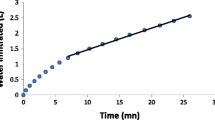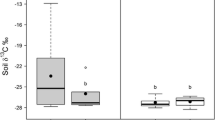Abstract
After earthworms of the species Aporrectodea caliginosa and A. rosea had burrowed in compacted cores of soil for 68 days the cores were sectioned horizontally. The upper surface of each sectioned layer of soil was photographed before it was dissected and the dimensions of all burrows within the layer measured. Volume densities calculated from the direct measurement of burrows were compared with the values calculated by stereology from data obtained from two image analysis methods, computerised image analysis and point counting with a systematic lattice. The assumption implicit in all stereology calculations was satisfied for this experiment in that the burrows of both species showed no preferred orientation in the compacted soil. Computerised image analysis could not measure the density of all burrows in the photographs because of the lack of contrast between cast-filled burrows and the soil and the complex shapes of the burrows. Although the volume densities of A. caliginosa burrows calculated from point counts were correlated with the values calculated from direct measurement, point counting over-estimated volume densities by two to three times. In the experiment, A. rosea produced too few airfilled burrows for the lattice to detect. The relative ratios of air-filled to cast-filled burrows calculated from the point counts suggested that approximately two-thirds and eight-ninths of the burrows of A. caliginosa and A. rosea, respectively, were filled with casts.
Similar content being viewed by others
References
Anderson JM (1988) Invertebrate-mediated transport processes in soils. Agric Ecosyst Environ 24:5–19
Barley KP (1959) Earthworms and soil fertility. IV. The influence of earthworms on the physical properties of a red-brown earth. Aust J Agric Res 10:371–377
Bouché MB (1975) Fonctions des lombriciens. III. Premières estimations quantitatives des stations francaises du PBI. Rev Ecol Biol Sol 12:12–25
Edwards CA, Lofty JR, (1977) Biology of earthworms, 2nd edn. Chapman and Hall, London
Edwards WM, Shipitalo MJ, Owens LB, Norton LD (1990) Effect of Lumbricus terrestris L. burrows on hydrology of continuous no-till corn fields. Geoderma 46:73–84
Ehlers W (1975) Observations on earthworm channels and infiltration on tilled and untilled loess soil. Soil Sci 119:242–249
Jakobsen BF, Dexter AR (1988) Influence of biopores on root growth, water uptake and grain yield of wheat. Prediction from a computer model. Biol Fertil Soils 6:315–321
Kretzschmar A (1978) Quantification ecologique des galéries de lombriciens. Techniques et premières estimations. Pedobiologia 18:31–38
Kretzschmar A (1987) Soil partitioning effect of an earthworm burrow system. Biol Fertil Soils 3:121–124
McKenzie BM (1988) Earthworms and their tunnels in relation to soil physical properties. PhD thesis, University of Adelaide, Adelaide
McKenzie BM, Dexter AR (1993) Size and orientation of burrows made by the earthworms Aporrectodea rosea and A. caliginosa. Geoderma 56:233–241
Omoti U, Wild A (1979) Use of fluorescent dyes to mark the pathways of solute movement through soils under leaching conditions: 2. Field experiments. Soil Sci 128:98–104
Ringrose-Voase AJ (1991) Micromorphology of soil structure: Description, quantification, application. Aust J Soil Res 29: 777–813
Schrader S (1993) Semi-automatic image analysis of earthworm activity in 2D soil sections. Geoderma 56:257–264
Springett JA (1985) Effect of introducing Allolobophoga Ude on root distribution and some soil properties in New Zealand pastures. In: Fitter AH, Atkinson D, Read DJ, Usher MB (eds) Ecological interactions in soils: Plants, microbes and animals, Blackwell Scientific, Oxford, pp 399–405
Weibel ER (1979) Stereological methods, vol 1. Practical methods for biological morphometry. Academic Press, London
Author information
Authors and Affiliations
Rights and permissions
About this article
Cite this article
Hirth, J.R., McKenzie, B.M. & Tisdall, J.M. Volume density of earthworm burrows in compacted cores of soil as estimated by direct and indirect methods. Biol Fertil Soils 21, 171–176 (1996). https://doi.org/10.1007/BF00335930
Received:
Issue Date:
DOI: https://doi.org/10.1007/BF00335930




